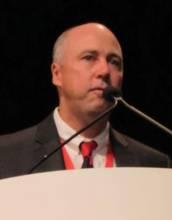ORLANDO – Intracoronary delivery of bone marrow cell therapy 2 to 3 weeks after a first myocardial infarction is safe, but does not improve global or regional function at 6 months follow-up, results from a prospective, randomized controlled trial suggest.
Early trials dating back to 2006 suggested that the delivery of autologous bone marrow mononuclear cells (BMC) was feasible in clinical practice, safe, and potentially effective in increasing cardiac function. Predictors of efficacy appeared to be low ejection fraction and relatively late timing of BMC infusion at about 5 to 7 days post-myocardial infarction (MI), explained Dr. Thomas Eschenhagen, of the Hamburg (Germany) Institute of Experimental Pharmacology and Toxicology, who discussed the findings presented at the annual scientific sessions of the American Heart Association.
He suggested that possible reasons for the lack efficacy of BMC therapy in this latest trial, known as Late TIME (Use of Adult Autologous Stem Cells in Treating People 2 to 3 Weeks After Having a Heart Attack), may be the timing of the infusion more than 2 weeks after percutaneous intervention. In addition, the trial was small (87 patients), and the cells were not tested for efficiency in an animal model, although the in vitro data were convincing. But, he added, "It could as well mean that bone marrow cell therapy is inefficient."
Dr. Eschenhagen made a back-of-the-envelope calculation based on 11 BMC studies including Late TIME conducted from 2004 to 2011 that showed a mean weighted gain in left ventricle function of just 0.43%. The best results were reported early on in BOOST (BNP Therapy Observation Unit Outcomes Study), finding a 6% improvement in left ventricle ejection fraction (LVEF) between BMC and controls, while the 2011 BONAMI (BOne Marrow in Acute Myocardial Infarction) trial came in at the bottom of the list with an LVEF loss of 0.3%.
"Late TIME adds to a number of recent BMC trials with neutral outcome, arguing against the therapeutic efficacy of BMC therapy in acute or subacute MI," he concluded.
Among the 87 patients randomized in Late TIME, bone marrow aspiration and intracoronary infusion of 150 x 106 total nucleated cells was performed at a median of 17.4 days in the BMC group and 16.8 days in the placebo group following primary percutaneous intervention. It was thought that later delivery may be particularly important for patients initially too sick or who present to hospitals without the capacity to perform cell therapy, said study author, Dr. Jay Traverse, with the Minneapolis Heart Institute at Abbott Northwestern Hospital.
The high-risk cohort had predominantly large, anterior MIs and a mean LVEF of 36.4% in the 58 BMC patients and 35% in the 29 placebo patients. Their mean peak creatine kinase MB fraction was 234 and 318, respectively, two-third received a drug-eluting stent, and more than half were smokers or had hyperlipidemia.
At 6 months, there was a gain in LVEF of just 0.5% (48.7% to 49.2%) in the BMC group, compared with 3.5% (45.3% to 48.8%) in the placebo group, which was not significantly different (P value = .14), Dr. Traverse said.
The coprimary end point of change in wall motion also was similar at 6 months among the 81 evaluable patients. Wall motion in the infarct zone changed from a mean of 6.2 mm to 6.5 mm in the BMC group and from 4.9 mm to 5.9 mm in the placebo group. Wall motion in the border zone changed from a mean of 16 mm to 16.6 mm in the BMC group and from 16.1 mm to 19.3 mm in the placebo group.
Both groups experienced a similar change in infarct size and left ventricular volumes at 6 months, he said.
Only one death occurred in the placebo group and one repeat MI in the BMC group. Repeat revascularization was required in three placebo-treated patients and one patient receiving BMC therapy. Two patients in the placebo group required placement of an implantable cardioverter defibrillator and one BMC patient was hospitalized for heart failure. Total events significantly favored the BMC group at 5% vs. 17%, Dr. Traverse said.
The study was simultaneously published online (JAMA 2011 Nov. 14 [doi: doi:10.1001/jama.2011.1670]).
Late TIME was sponsored by the National Heart, Lung, and Blood Institute. Dr. Traverse reported no conflicts, and a coauthor reported serving as a consultant for Juventas Therapeutics and Aastrom Biosciences and grant funding from Athersys.


